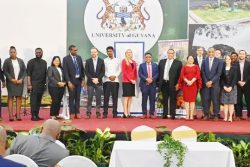Like his immediate predecessor, the new Vice Chancellor of the University of Guyana, Professor Jacob Opadeyi, has been speaking of the desirability of a partnership between the University of Guyana and the private sector. The former Vice Chancellor, Professor Lawrence Carrington, had spoken in glowing terms about such a partnership during a forum convened at a city hotel. Thereafter, a framework for a UG-private sector partnership was discussed and a group of private sector and UG officials were identified to oversee the arrangement.
The idea at the time appeared to be to create linkages between the various faculties of the university and the private sector entities under an arrangement that would see the private sector providing support for the faculties in order to better position them to turn out graduates who would help meet the skills needs of the private sector.
Professor Opadeyi and Professor Carrington before him would have been aware of the increasing global focus on collaboration between state-run universities and the private sector in both the major metropolitan capitals and the emerging economies of Asia. Both would also have been made aware of the continual decline of the University of Guyana, a circumstance that has resulted primarily from the inability of the state to fund the university to a level that allows it to perform its functions anywhere near as effectively as it should.
Partnerships of one sort or another between UG and the private sector have been ongoing for several years. Those that come immediately to mind are the student dormitories set up at Turkeyen, first, by the New Building Society and subsequently by the Beharry Group of Companies. Then there is the Cheddi Jagan Lecture Theatre financed by an endowment fund and the internet facilities provided by GT&T and various other private sector-driven contributions to UG undertaken by business entities like Laparkan, Texaco (Rubis), Barama, Macorp, Demerara Tobacco and Republic Bank, among others.
Arguably, the expansion of the private sector through the advent of foreign investors particularly in the mining and oil exploration sectors could provide further potential for public-private sector partnership to develop the university. The Canadian mining entities with significant investments in Guyana may well be inclined to support the development of those faculties at UG that might add skilled workers to its labour force.
Constructive collaboration between the Univer-sity of Guyana and the private sector reposes in the ability of the two to jointly develop strong and well-defined programmes aimed at exploring and exploiting areas of cooperation that accelerate linkages between higher education and industry. Of course, the success of these linkages would depend heavily on the preparedness of government to play a part by offering incentives – like linking tax breaks to private sector grants for research at UG – and creating the necessary environment in which such initiatives can thrive. Similar strong initiatives developed in Asia have witnessed successful collaboration with universities and several leading global industry players.
The case for a significantly strengthened relationship between the University of Guyana and the private sector is made even stronger by current research which suggests that universities may have become so preoccupied with getting students ‘in the door,’ so to speak that they lose sight of how to prepare young people to succeed in the tough contemporary labour market. Indeed, there have been far too many instances right here in Guyana where students enter the job market armed with the requisite academic qualifications but still not necessarily qualified to work.
We know little about the outcomes of the University of Guyana-private sector initiative undertaken at the start of Professor Carrington’s tenure, though it has to be said that one cannot point to a great deal in terms of accomplishment that derived from that arrangement. It may well be that Professor Carrington became so engrossed in the day-to-day grind of running the university that some things may well have gotten shifted to the back burner.
What we do know – based on conversations with a few private sector functionaries – is that some businessmen who may have bought into the idea of the UG-private sector partnership in the first place might have reconsidered their positions in the light of the degree of political control that obtained at Turkeyen. It should be noted too that some of the country’s major business houses that might otherwise have looked to the University of Guyana to help meet their human resource needs are currently utilizing various residential and online courses offered by various overseas universities.
Given the dire circumstances in which the University of Guyana finds itself it is altogether worth the while for the new Vice Chancellor to reach out to the private sector, though one cannot help but wonder whether we will ever go beyond the various one-off private sector initiatives to support the university and move into the realm of a structured, long-term support programme. Perhaps the initiative envisaged under the new Vice Chancellor might even benefit from such progress which may have been made under the earlier initiative that coincided with the start of his predecessor’s tenure.








